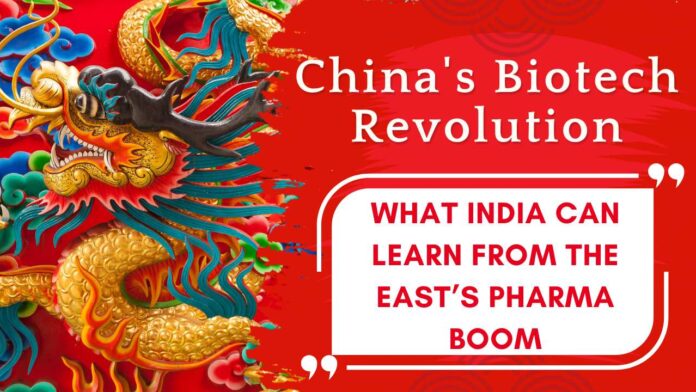China’s Biotech Revolution: What India Can Learn From the East’s Pharma Boom
The pharmaceutical industry is changing. The U.S. and Europe are no longer leading. New players are emerging in life sciences. One is China. While China is often associated with manufacturing capabilities at scale, it is developing a biotech sector of its own. With strategic investments, regulatory reforms, and a strong pool of talented scientists, the country is reshaping the future. They are rewriting the future of the pharmaceutical industry.
In recent years, American pharmaceutical companies have turned to China for partners more than at any previous time. This is a noteworthy change in the global pharmaceutical industry. Companies, like AbbVie, AstraZeneca, and Merck, have made multi-billion-dollar agreements with Chinese pharmaceutical companies. This also reflects the rising status of China in biotech. Other Chinese companies, making waves in this shift, are Simcere Zaiming, CSPC Pharma, and Hansoh Pharma.
But why does this matter to India? India has been a leader in the world of generic drugs, but has not made an inroad in drug development. The emergence of the Chinese biotech industry presents both a challenge and an opportunity for India. Will it adapt and compete in this new world, or simply risk falling behind in the race for drug innovation?
India is known worldwide for being a low-cost destination for generic medicines. The country has made a significant contribution in the area of health accessibility and affordability, especially in developing countries. Thanks to its strong manufacturing capabilities and low cost of production. However, the reliance on generics has created challenges for the development of the innovation industry. While this occurs, China has become a dominant force in pharmaceutical innovation and has attracted the largest world’s pharmaceutical companies.
This transformation didn’t happen overnight! This is the result of a thoughtfully developed plan, executed over almost 20 years. At the center of this biotechnology transformation are researchers who have returned to China after studying at elite schools all over the globe. These researchers, referred to as “sea turtles”, brought back knowledge and skills that will generate innovative drug policies and place China at the forefront of medicinal drug research.
According to a report from Stifel published in January 2025, there has been significant progress in China. Today, nearly one-third of all the molecules tested globally are from China. From 2022 to 2024, Chinese biotech companies have added over 4,100 new drugs to their pipelines. These medications meet the higher standards common to more reputable Western pharmaceuticals. Yet they are sold at far lower prices, which makes China a more competitive force in the global marketplace.
Brad Loncar, who is an American investor and head of a company called BiotechTV, has pointed out that the biotechnology industry is changing. He notes that by 2024, Chinese biotechnology companies received $6 billion in upfront payments from foreign pharmaceutical companies. The deals assist companies outside of China in gaining access to innovative drug candidates from China. They have played an important role in the biotechnology industrial growth in the country. China is no longer merely a manufacturing hub. It has moved to an up-and-coming biotech leader.
A specific instance of this is Akeso, a small biotechnology company in China. With an innovative lung cancer treatment called Ivonescimab. It announced its entry into the marketplace with an innovative treatment for lung cancer called Ivonescimab. In clinical trials, it performed better than Merck’s Keytruda, which had over $25 billion worldwide sales in 2023.
In light of Akeso’s success, leading global pharmaceutical giants are actively looking at partnering with China. AbbVie recently invested in a $1 billion deal with Simcere Zaiming for the treatment of multiple myeloma. Merck partnered with Hansoh Pharma to treat obesity. AstraZeneca will work with CSPC Pharma on cardiac drugs. These partnerships show the world no longer sees China as just a source of cheap labor and raw materials. They are now key players in drug innovation.
China’s growth in the pharma industry poses both a challenge and an opportunity for India. India has established itself in generic medicine, but it still struggles. India has made progress in oncology and immunotherapy. The transition from generics to novel drug development is a disadvantage for India’s pharma industry in the global market.
Regulatory obstacles and bureaucratic lags create a considerable set of challenges for India. Experts have gone so far as to say that China has become so successful in biotech commercialization because of its speed and efficiency in regulatory approval. In China, you will see a faster review of clinical trials, a faster review of data, and eventually a review of a drug’s likelihood to be successful. By using an efficient approach to regulation, Chinese companies can save a fortune in trial-and-error costs. In contrast, India’s more conservative regulatory approach results in fewer than 100 clinical trials conducted a year, while China performs upwards of 1,000 clinical trials a year.
GV Prasad, the co-chairman of Dr. Reddy’s Laboratories, stated that India’s slow progress with respect to innovative drug discovery. Mr. Prasad discussed the fact that China is leading the world in oncology. He mentioned that high-quality clinical trials and research underpin success in drug discovery. He noted that India should concentrate on innovative drug discovery if it hopes to compete internationally.
As China’s biotech industry continues its upward trajectory, India has two key lessons to learn. The first is that India needs to invest more in research and development (R&D). Even though India has the third-largest pharmaceutical market in the world by volume, it is only 14th by value. If India wants to have a higher value and a greater share of the global market, it must emphasize innovation. Innovation will require investments in R&D and developing an ecosystem that fosters innovation and entrepreneurship.
Another major takeaway for India is the necessity to build a conducive and sustainable ecosystem for innovation. China has a strong biotech ecosystem, which is why it is generating talent from multiple countries. India now must build an ecosystem to bridge the divide between academia, industry, and the government. With numerous biotech startups coming up and regulatory challenges streamlined, India’s path to market for drug development should then be simplified.
Yet, there are glimmers of hope. Companies like Glenmark, Zydus Lifesciences, and Cipla have made good progress in biotech research. Glenmark is working with Ichnos on a treatment for multiple myeloma. Glenmark is making advances in CAR T-cell therapy and has caught the attention of the global marketplace. India’s government provides funding and tax incentives for biotech start-ups and invests in research and development. Leading experts state that more action is required to stimulate an innovation ecosystem. All India has to do is catch up and become a global leader and an innovation ecosystem will develop.
China’s biotechnology rise offers distinct lessons for India. India must invest in research and development, streamline regulations, and ensure an engaged ecosystem. While India has performed well in generics, innovation is needed to remain competitive in a fast-paced global pharmaceutical industry.



























